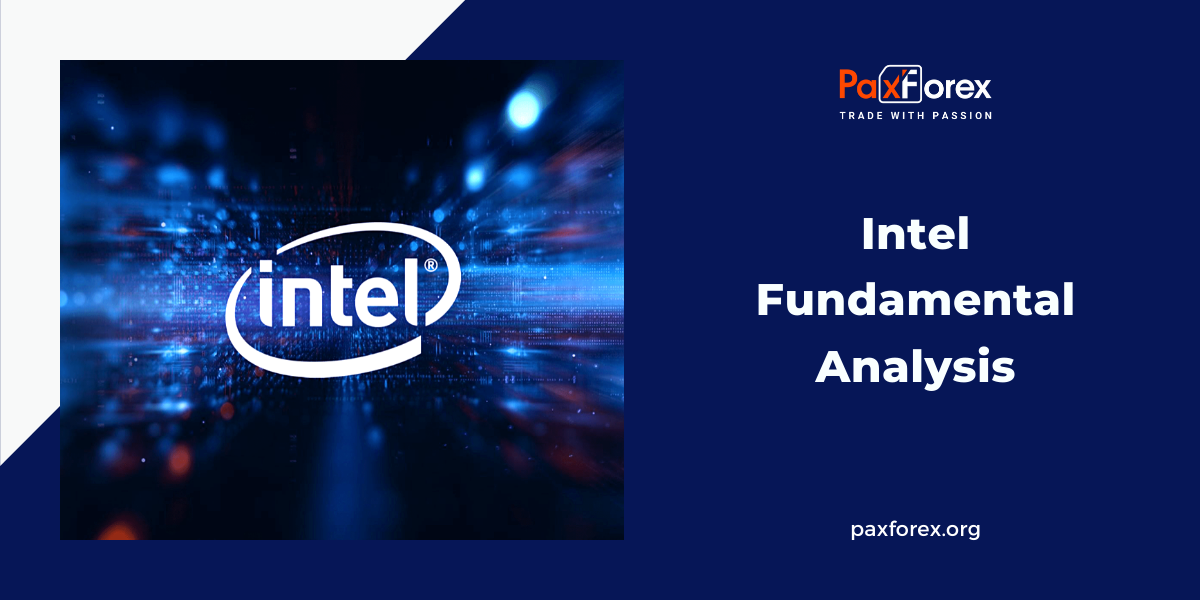
Source: PaxForex Premium Analytics Portal, Fundamental Insight
Intel's data center and artificial intelligence (AI) segment, which includes server CPUs, data center GPUs, and AI chips, experienced a 15% year-over-year decline in revenue during the second quarter. The silver lining is that this decline represents an improvement over the first quarter's 39% slump. However, the road to recovery will be a gradual one.
In contrast to the PC CPU market, where Intel has largely reclaimed its performance leadership from rival Advanced Micro Devices (AMD), the situation in the data center CPU market is much more challenging. Intel faced chronic delays with its innovative line of data center CPUs, known as Sapphire Rapids, which come equipped with specialized accelerators for various workloads. Despite launching Sapphire Rapids early this year and nearing the sale of its 1 millionth chip, the delays allowed AMD's Genoa family of data center CPUs to gain a substantial advantage in terms of core density. These Genoa chips were hailed by Tom's Hardware as a "server slam dunk," particularly excelling in workloads that benefit from extensive parallel processing, even with Sapphire Rapids now available.
Adding to Intel's struggles, customers are taking longer than expected to work through their data center CPU inventories. The company anticipates this inventory correction to persist into the second half of the year, resulting in reduced demand for its data center CPUs. Additionally, the surge in interest in artificial intelligence has a mixed impact on Intel. While the company sees healthy demand for its data center GPUs and other AI accelerators, it faces a setback in CPU sales as customers prioritize AI accelerators over general compute capacity.
Due to these challenges, Intel foresees a decline in data center CPU sales during the third quarter compared to the second quarter. However, the company remains optimistic about a rebound in the fourth quarter and believes that demand for data center CPUs will eventually rise in the long run.
Intel is determined to regain its competitive edge against AMD, but it's not going to happen overnight. The next CPU release in their pipeline is Emerald Rapids, scheduled for the fourth quarter of this year. However, it's expected to use the same Intel 7 manufacturing process as its predecessor, Sapphire Rapids, and won't see a substantial increase in the maximum number of cores supported. As a result, Emerald Rapids might not be the game-changer Intel needs to catch up.
The real excitement begins in 2024 with the launch of Granite Rapids. This successor to Emerald Rapids will utilize the upcoming Intel 3 manufacturing process, bringing significant efficiency gains. Additionally, Intel plans to introduce Sierra Forest, a new line of data center CPUs targeting cloud workloads. Sierra Forest will incorporate Intel's lower-power efficiency cores, potentially packing up to 144 cores into a single chip. Following this, Clearwater Forest is set to arrive in 2025, leveraging the advanced sub-2nm Intel 18A manufacturing process.
In the meantime, Intel's data center segment faced challenges in the second quarter, leading to unprofitability. Lower demand, reduced factory utilization, and a less favorable product mix all contributed to this situation. The company does have a strong roadmap for the future, but a quick turnaround is unlikely. Real progress may not materialize until 2024, and that's contingent on the successful and timely launch of their next-generation products, delivering the anticipated performance and efficiency.
While Intel possesses a strong roadmap for the future, achieving a quick turnaround will be challenging. A true resurgence may only materialize in 2024, dependent on the successful launch and performance of their next-generation products. As Intel strives to regain its competitive edge, time will be a crucial factor in determining its future prospects in the data center and AI market.
As long as the price is above 34.00, follow the recommendations below:
- Time frame: D1
- Recommendation: long position
- Entry point: 35.86
- Take Profit 1: 38.00
- Take Profit 2: 41.00
Alternative scenario:
If the level of 34.00 is broken-down, follow the recommendations below:
- Time frame: D1
- Recommendation: short position
- Entry point: 34.00
- Take Profit 1: 32.00
- Take Profit 2: 30.00













